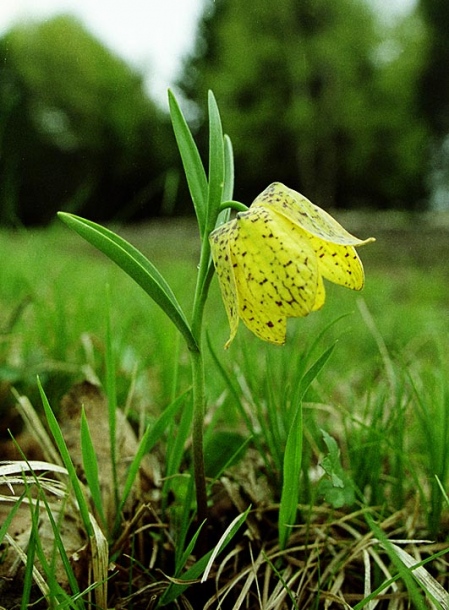Fritillaria collina: Red Data Book of Armenia

EN B 1 ab(i,ii,iii,iv) + 2 ab(i,ii,iii,iv)
Category. Endangered species. Endemic of the Caucasus. In Armenia it occurs in five floristic regions, nevertheless it is very rare. The extent of occurrence is less than 5000 km2, the area of occupancy is less than 500 km2. In the first edition of the Red Data Book of Armenia it was included as Fritillaria lutea under Category 1: Endangered species. It is not included in the Annexes of CITES and that of the Bern Convention.
Description. Herb with white globular bulb. Stem 12–20 cm, glabrous, in the basal part leafless, in the upper half with 4–6 alternate, narrowly lanceolate or linear leaves. Flower light yellow, large 30–40 mm long, broadly campanulate. Capsule ovale–obovate, obtuse, 3–edged.
Distribution. In Armenia it occurs in Upper Akhuryan, Shirak, Lori, Idjevan and Sevan floristic regions. EOO is 2790 km2, AOO is 60 km2, the number of locations is 5. Besides Armenia the general area of distribution includes the Greater Caucasus and West, South–West, Central, East and South Transcaucasia.
Ecological, biological and phytocoenological peculiarities. Grows from middle to sub–alpine belts, at the altitude of 1700–2500 meters above sea level, in the forest glades and forest edges, in sub–alpine birch forests, on rocky places in sub–alpine meadows. Flowering from May to June, fruiting from June to August.
Limiting factors. Restricted extent of occurrence and area of occupancy, loss/degradation of habitats caused by land development, intensive grazing, recreation trampling.
Conservation actions. The part of population grows in the area of "Dilidjan" National Park. Necessary: monitoring of the population state.
Suggestions
 The Ministry of Environment sent a letter international partners to draw their attention to the real danger of environmental disasters as a result of Azerbaijan's large-scale aggression towards the territory of Armenia
The Ministry of Environment sent a letter international partners to draw their attention to the real danger of environmental disasters as a result of Azerbaijan's large-scale aggression towards the territory of Armenia
 Vicia pisiformis: Red Data Book of Armenia
Vicia pisiformis: Red Data Book of Armenia
 Vavilovia formosa: Red Data Book of Armenia
Vavilovia formosa: Red Data Book of Armenia
 Trigonella capitata: Red Data Book of Armenia
Trigonella capitata: Red Data Book of Armenia
 Trigonella astroides: Red Data Book of Armenia
Trigonella astroides: Red Data Book of Armenia












